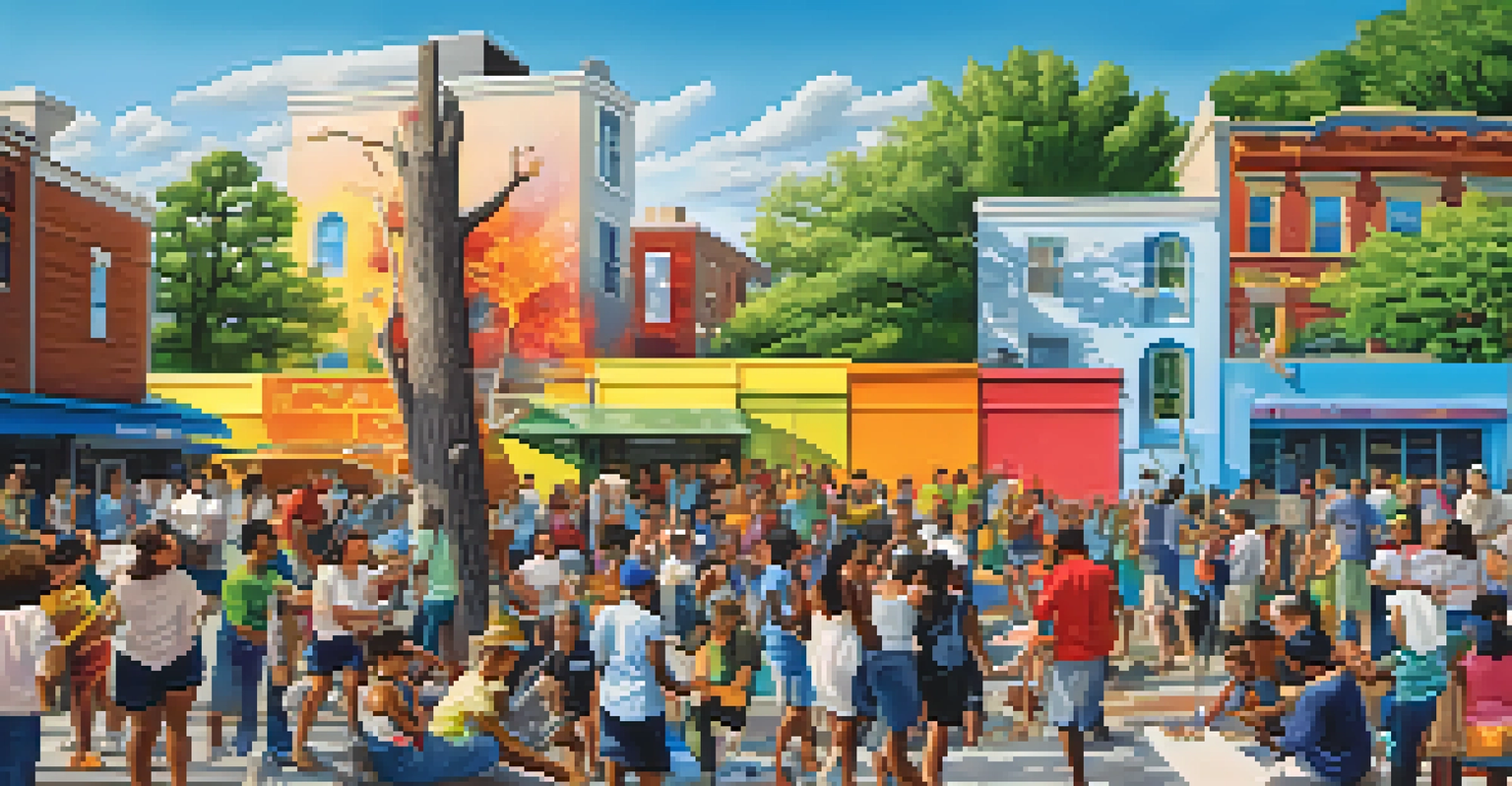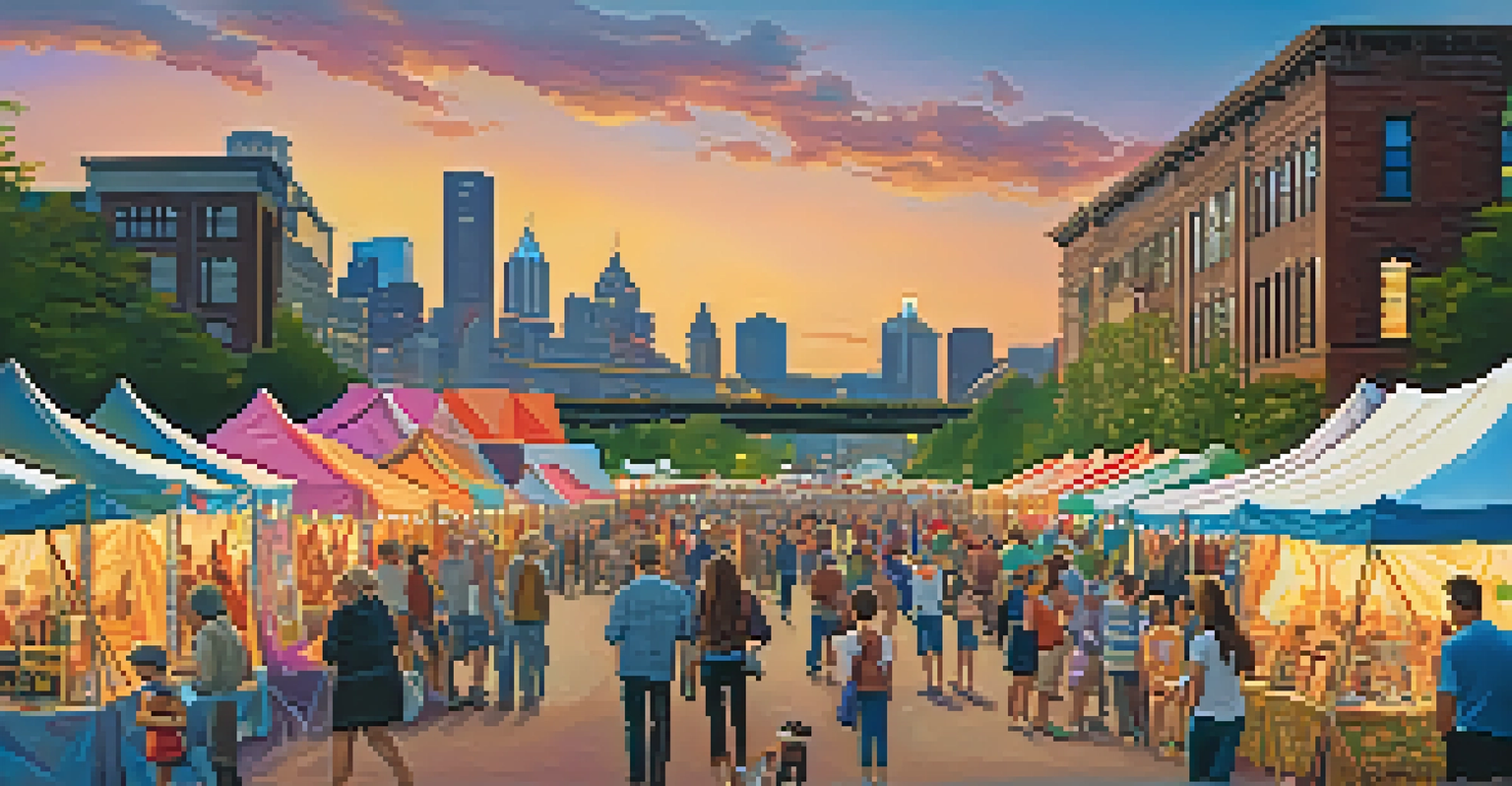The Role of Art in Revitalizing Pittsburgh's Urban Landscape

Art as a Catalyst for Urban Renewal in Pittsburgh
Pittsburgh's urban landscape has undergone significant transformation, and art plays a crucial role in this revitalization. From murals to sculptures, artistic expressions breathe new life into neglected spaces, turning them into vibrant community hubs. This transformation not only beautifies the city but also fosters a sense of pride among residents.
Art is not what you see, but what you make others see.
One striking example is the transformation of the Strip District, where colorful murals now adorn once-blank walls, attracting visitors and locals alike. These public artworks invite people to engage with their surroundings, turning the area into a cultural destination. This kind of urban renewal is about more than aesthetics; it encourages social interactions and community cohesion.
As art continues to reshape Pittsburgh, it serves as a reminder of the city's rich history and resilient spirit. By revitalizing urban spaces, art helps to create a unique identity for each neighborhood, ensuring that Pittsburgh remains a dynamic and evolving city.
Community Engagement Through Public Art Projects
Public art projects are more than just visual spectacles; they are powerful tools for community engagement. Initiatives like community mural projects invite local residents to collaborate, fostering a sense of ownership and pride in their neighborhood. These projects often reflect the stories, struggles, and aspirations of the communities they represent.

For instance, the 'Our Town' murals initiative has allowed diverse communities to share their narratives through art. This participatory approach not only beautifies the environment but also strengthens community bonds. As residents come together to create, they build relationships that transcend social barriers.
Art Transforms Urban Spaces
Art revitalizes Pittsburgh's urban landscape, turning neglected areas into vibrant community hubs.
Moreover, these collaborative efforts often lead to discussions about local issues, promoting civic involvement. When people see their ideas and contributions represented in public spaces, it empowers them to engage more actively in their community, resulting in lasting positive change.
Art as a Tool for Economic Development
Art has proven to be an effective tool for economic development in Pittsburgh. By attracting tourists and art enthusiasts, the city has seen a boost in local businesses, from cafés to galleries. This influx of visitors not only stimulates the economy but also encourages investment in the arts.
The arts are not a luxury; they are a necessity for the human spirit.
Events like the Pittsburgh Arts Festival showcase local talent while drawing crowds from beyond the city limits. These events create opportunities for artists to sell their work and gain recognition, contributing to a thriving creative economy. Additionally, the presence of public art often increases property values, making neighborhoods more desirable places to live.
As Pittsburgh continues to embrace its artistic identity, the economic benefits become increasingly evident. With each mural and installation, the city not only enriches its cultural landscape but also secures a brighter economic future.
Art and Social Justice: A Voice for the Marginalized
Art has long been a medium for social justice, and Pittsburgh is no exception. Local artists use their craft to address issues of inequality, discrimination, and social justice, sparking important conversations within the community. These artworks often serve as a powerful reminder of the struggles faced by marginalized groups.
For example, the 'Black Lives Matter' mural in the East End stands as a testament to the city's commitment to social equity. This mural not only beautifies the neighborhood but also confronts systemic racism and encourages dialogue about change. Such artistic expressions resonate deeply with residents, providing a platform for voices that are often overlooked.
Community Engagement Through Art
Public art projects foster community ownership and pride, encouraging collaboration among residents.
Through art, Pittsburgh fosters an environment where social issues can be openly discussed and addressed. This commitment to social justice through creativity is vital in ensuring that every community member feels heard and valued.
Cultural Festivals Celebrating Artistic Diversity
Cultural festivals play a significant role in celebrating Pittsburgh's artistic diversity. These events showcase a wide range of artistic expressions, from visual arts to performance, highlighting the city's multicultural fabric. Festivals like the Three Rivers Arts Festival bring together artists from various backgrounds, enriching the community's cultural landscape.
During these festivals, attendees have the opportunity to engage with artists and experience different art forms, fostering a deeper appreciation for creativity. Moreover, these events promote cross-cultural understanding, allowing individuals to learn from one another and celebrate their differences. This cultural exchange strengthens community ties and promotes inclusivity.
As Pittsburgh continues to host these vibrant festivals, it reinforces its identity as a hub for artistic innovation. By embracing diversity in the arts, the city nurtures an environment where creativity flourishes and all voices are celebrated.
The Role of Technology in Art Creation and Distribution
In today's digital age, technology plays an increasingly important role in art creation and distribution. Pittsburgh artists are leveraging tools like social media and digital platforms to share their work with a broader audience. This accessibility helps to break down barriers, allowing emerging artists to gain visibility and connect with potential patrons.
For instance, virtual galleries and online exhibitions have become popular, especially in the wake of the pandemic. These platforms not only showcase local talent but also allow artists to sell their work directly to consumers, creating new revenue streams. This shift towards digital has made art more accessible to everyone, regardless of geographic location.
Economic Growth via Artistic Identity
Art attracts tourism and investment, significantly boosting local businesses and property values in Pittsburgh.
As technology continues to evolve, it opens up new avenues for artistic expression. Pittsburgh's creative community is embracing these innovations, ensuring that art remains a dynamic and integral part of the urban landscape.
Education and Art: Nurturing Future Creatives
Education plays a vital role in nurturing the next generation of artists in Pittsburgh. Local schools and community organizations are increasingly incorporating arts education into their curricula, recognizing its importance in fostering creativity and critical thinking. Programs that emphasize art help students develop skills that are essential for success in various fields.
In addition to traditional art classes, initiatives like after-school programs and workshops provide hands-on experiences for young creatives. These opportunities allow students to explore different mediums and express themselves in unique ways. By encouraging artistic exploration, the city is investing in its future talent and creative economy.

Furthermore, partnerships between local artists and schools promote mentorship opportunities, connecting students with experienced professionals. This collaborative approach not only enhances education but also strengthens the community by bridging the gap between established artists and aspiring ones.
The Future of Art in Pittsburgh's Urban Landscape
Looking ahead, the future of art in Pittsburgh's urban landscape appears bright. With ongoing investments in public art and community initiatives, the city is poised to continue its journey of revitalization through creativity. As more artists and residents engage with their surroundings, the potential for transformation is limitless.
Pittsburgh's commitment to supporting the arts will likely attract even more creative talent, further enriching the cultural tapestry of the city. This influx of diverse voices will continue to inspire projects that reflect the community's values and aspirations. As a result, Pittsburgh will remain a dynamic and evolving urban environment.
Ultimately, the role of art in revitalizing Pittsburgh goes beyond aesthetics; it fosters community, encourages dialogue, and drives economic growth. As the city embraces its artistic identity, it strengthens its position as a vibrant hub for innovation and creativity.